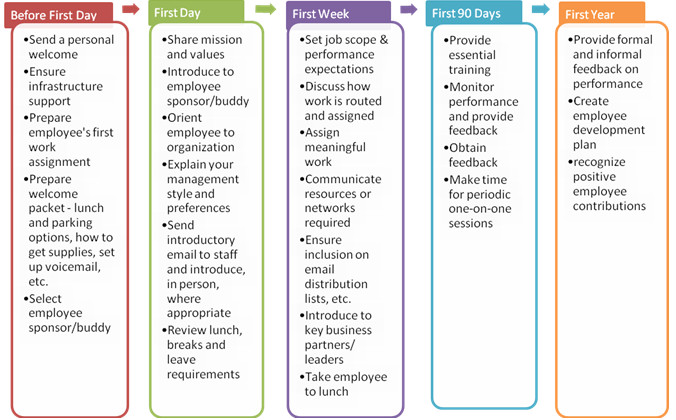Put yourself in the shoes of a new recruit in your organisation. You’re starting your dream job and you’re very slightly nervous. After all, it’s your first day and you want to make a good impression. So far, it’s been fairly easy…your offer letter told you to report to the Human Resources Office and you spent your first day, along with a number of other new hires, filling out forms and getting oriented to the company.
Now it’s day two and you’re actually reporting to your new office. You find the right building and floor, but it all goes downhill from there.
No one seems to have expected you. After some time, a place is found for you to sit, but there’s no computer or telephone and it sounds as if it will be a week or so before they’ll arrive. Your line manager doesn’t seem to have any work assignments for you and has given you a binder of material to read through. Everyone seems busy except you and you’re wondering if you’ve made some horrible mistake. The worst part is you can’t even find the toilets!
Smart managers know that onboarding is a crucial part of building employee engagement, satisfaction and success. A review of current research shows a clear correlation between effective onboarding efforts and improvements in employee performance and reductions in turnover. One recent study[1], for example, found that effective onboarding programmes can improve employee performance by over 10 percent.
Another study[2] found that UK and US businesses lose an estimated £23 billion each year, primarily because of a lack of employee clarity around job roles and responsibilities. Key onboarding activities, such as clearly communicating performance expectations, providing explicit linkages to organisational mission and values, giving feedback, involving co-workers and peers, and providing training, are crucial to employee and organisational success.
[cm_form form_id=’cm_65a14c3f5da64′]
Before we discuss the details of your onboarding efforts, let’s make sure that we share a common understanding of the term.
It’s often the case that induction, new employee orientation and onboarding are used interchangeably, but there are significant differences between them. Induction generally refers to the process of filling out forms, getting an overview of employment benefits, and so on. New employee orientation is often done in conjunction with induction and includes an introduction to the company and its structure.
Onboarding is a longer-term process that focuses on helping new employees become a part of the organisation, building crucial relationships, understanding their role and learning how they add value.
A review of the literature shows that there are wide variations in the duration of onboarding programmes – from days, to weeks, to months and up to a year.
It is likely that the duration of the programme will vary with the type of position, but the overall objectives – to ensure that the employee feels connected to the organisation, builds key relationships and understands how he or she fits in to the overall mission and values – are the same, regardless of the length of the programme.
So, what, specifically, should the smart manager do to ensure effective onboarding? A review of best practices suggests the following activities as a starting point. Tailor these for your own organisation and track the impact on your new employees.

The sponsor/buddy is someone who can answer, in a positive way, questions about the work environment, the culture and norms, and the unwritten policies and procedures.
The sponsor will help socialise the new employee, taking him or her to lunch, introducing them to peers, and helping them find needed resources.
When choosing a candidate for this role, look for someone who has the time to be accessible, holds a job that is similar to that of the new employee, has a good performance record and enjoys working for the organisation, is well regarded by others in the department, has good interpersonal skills and has a strong sense of confidentiality.
Finally, keep in mind that it’s also important to pick and choose how to engage the new employee. It’s easy to be overwhelmed in the beginning.
An employee who is introduced to an entire staff in the course of a single day is likely to find it stressful to try to remember all of those names. Being assigned the task of reading voluminous materials for hours at a time can also crush enthusiasm for the job as new employees feel there is no “real work” to do.
When new employees start, follow this recipe for successful onboarding and see the difference it can make.





